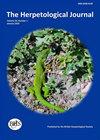腹侧纹可以用来识别易受攻击的比利牛斯河溪蝾螈吗?
IF 1.1
4区 生物学
Q3 ZOOLOGY
引用次数: 1
摘要
对动物物种的个体识别是捕获标记再捕获(CMR)研究的先决条件。对于两栖动物来说,身体模式的光识别是一种非侵入性的、比经典标记方法(如无源集成转发器)便宜的替代方法。然而,只有当模式(i)在个体之间足够可变,以及(ii)随着时间的推移稳定时,照片识别才是有效的。这种方法也取决于观察者的判断。在本研究中,我们评估了自动算法(AmphIdent)识别法国比利牛斯山脉特有的比利牛斯溪蝾螈(Calotrion asper)腹部颜色模式的有效性。为了评估测试方法的性能,用无源集成转发器(PIT标签)标记了来自两个不同流的113个人。我们使用误拒绝率(FRR)、误接受率(FAR)和真接受率(TAR)作为指标来评估光识别的性能。两种流、两性和所有观察者的平均FRR为7.3%,FAR为5.2%,TAR为92%。FAR在性别之间有显著差异,而FRR和TAR受性别和溪流之间的相互作用的显著影响。尽管存在这些差异,但我们的错误率是两栖动物和非两栖动物计算机辅助照片识别的最低值之一。我们发现,当第一次拍摄后的时间增加时,低质量的参考图片可能会导致实现正确匹配的难度增加。因此,使用AmphIdent软件进行个人照片识别是一种可靠的工具,有助于监测比利牛斯溪蝾螈,前提是要小心拍照,定期更新参考图像,并对观察者进行适当的培训,使其能够使用该软件并解读图像。本文章由计算机程序翻译,如有差异,请以英文原文为准。
Can ventral pattern be used for individual recognition
of the vulnerable Pyrenean brook newt (Calotriton asper)?
Individual recognition of animal species is a prerequisite for capture-mark-recapture (CMR) studies. For amphibians, photoidentification of body pattern is a non-invasive and less expensive alternative than classical marking methods (e.g. passive integrated transponder). However, photo-identification is effective only if the patterns are (i) sufficiently variable between individuals, and (ii) stable over time. This method also depends on the observer’s judgment. In the present study, we assessed the effectiveness of an automatic algorithm (AmphIdent) to recognise ventral colour patterns of the Pyrenean brook newt (Calotrion asper), endemic to the Pyrenees Mountains of France. To assess the performance of the tested method, 113 individuals from two different streams were marked with passive integrated transponders (PIT-tags). We used false rejection rate (FRR), false acceptance rate (FAR) and true acceptance rate (TAR) as metrics to evaluate performances of photoidentification. Mean FRR was 7.3 %, FAR was 5.2 %, and TAR was 92 % across both streams, both sexes and all the observers. FAR was significantly different between sexes, while FRR and TAR were significantly influenced by the interaction between the sex and the stream. Despite these differences, our error rates are among the lowest values found in the literature for both amphibian and non-amphibian computer-assisted photo-identification. We found that poor-quality reference pictures could lead to an increasing difficulty to achieve a correct match when time since first capture rose. Consequently, individual photo-identification using AmphIdent software is a reliable tool to aid in the monitoring the Pyrenean brook newts, provided that pictures are taken with care, reference images are regularly updated and observers are properly trained to use the software and interpret images.
求助全文
通过发布文献求助,成功后即可免费获取论文全文。
去求助
来源期刊

Herpetological Journal
生物-动物学
CiteScore
2.40
自引率
10.00%
发文量
25
审稿时长
>12 weeks
期刊介绍:
The Herpetological Journal is the Society''s prestigious quarterly scientific journal.
 求助内容:
求助内容: 应助结果提醒方式:
应助结果提醒方式:


